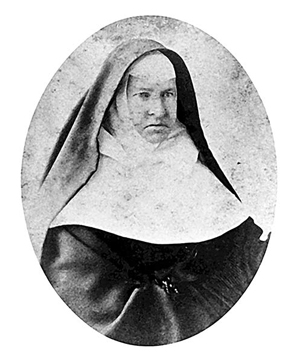Sister Mary Bernard Dickson
A biography written by Mary de Porres rsm
Sister M. Bernard Dickson is regarded as the founding sister of the Sisters of Mercy, Wellington, New Zealand. It was she together with Sister M. Augustine Maxwell and a postulant, Marie Deloncle who responded to the plea for help from Wellington’s faltering mission.
 They arrived on 14 June 1861 and immediately injected new life and hope. The Bishop of Wellington, Philippe Viard S.M., named Bernard as the superior because of the qualities of strength of character and maturity that he saw in her.
They arrived on 14 June 1861 and immediately injected new life and hope. The Bishop of Wellington, Philippe Viard S.M., named Bernard as the superior because of the qualities of strength of character and maturity that he saw in her.
Bernard was born Julia Diana Dickson in 1810, the daughter of upper middle class parents, Richard Lothian and Julia Dickson at Ipswich, Suffolk, England. She converted to Catholicism in Edinburgh at the age of 35 in 1845 and on 1 May 1847, entered the Mercy Convent at Bermondsey. After her profession in 1850, she moved to Chelsea Convent and during the next four years gained nursing experience at St George’s Hospital, London.
With the outbreak of the Crimean War in 1854 and the appeal for nurses, Bernard volunteered and joined a group of fourteen Sisters of Mercy led by Mother M. Frances Bridgeman. Already in the Crimea were five Mercy Sisters from Bermondsey, and their wonderfully heroic work led to an appeal for more sisters. Bernard was assigned to serve under Florence Nightingale with four Mercy companions at Scutari. Conditions were appalling and disease was rife. Within a short while, Bernard suffered severe frostbite to her hands and face and was to carry the scars for the rest of her life. She fell ill with typhoid fever and on two occasions was near to death. She was invalided home in 1855 where eventually she made a full recovery.
On her return, Bernard learned of an appeal for assistance being made from far-flung Auckland, New Zealand. In characteristic fashion, she volunteered for this mission, and together with five Irish Sisters of Mercy, travelled half way around the world to respond to that call. They arrived on 5 August 1857 after many months of hazardous living on board ‘The Dinapore.’
As the Auckland community had no hospital, she commenced teaching French in the select school plus visiting and caring for the sick, poor and orphaned. For the next four years she threw herself wholeheartedly into this work.
Then a further cry came for help - this time from Wellington, and again, Bernard volunteered most willingly and arrived with two companions on 14 June 1861. Here she laboured with her many talents, teaching the children of both the Maori and colonial settlers. In 1863, with the population and school roles increasing, she requested another sister from Auckland. In that same year, three young sisters were admitted to Holy Profession, and thus the Congregation of the Sisters of Mercy was established in Wellington.
By 1873, advancing in years and suffering from permanent lameness, Bernard sought to relinquish her responsibility, and appealed to Melbourne, Australia, for recruits. Two sisters responded. So, after thirteen years as Mother Superior, Bernard was free, not to live a more leisurely life, but to fulfil a long standing invitation to found a convent at Ahaura on the West Coast of New Zealand’s South Island. She set off with two companions to this small gold mining town where conditions were very primitive with a proliferation of hotels, few families and a predominantly young, male population. It was in reality ‘the wild west’!
For an English woman of fine breeding and no longer young, the situation must have been extremely difficult but with her usual zeal, she worked on for two years. However, strife arose between the new bishop of Wellington, Bishop Redwood, and herself over matters of authority, and she was dismissed. The bishop desired her to return to Bermondsey and gave her the required fare.
Eventually, Bernard did return to Bermondsey but did not stay. She came back to Auckland and rejoined the community there where she died on 5 August 1895, having served the New Zealand people for thirty-eight years.
Mother M. Bernard was laid to rest in the small cemetery in Auckland’s St Mary’s Convent grounds. While Lord Bledisloe was Governor-General of New Zealand, each year he laid a wreath on her grave in recognition of her nursing services in the Crimean War.
Wellington is very indebted to Mother M. Bernard Dickson who was, in truth, a valiant woman.
References
- Abel, G.B. A Crimean Veteran. CPC, Auckland.
- Kirk, Marcienne D, Remembering Your Mercy: Mother Mary Cecilia Maher & the First Sisters of Mercy in New Zealand 1850 – 1880. Auckland, Sisters of Mercy, 1998.

